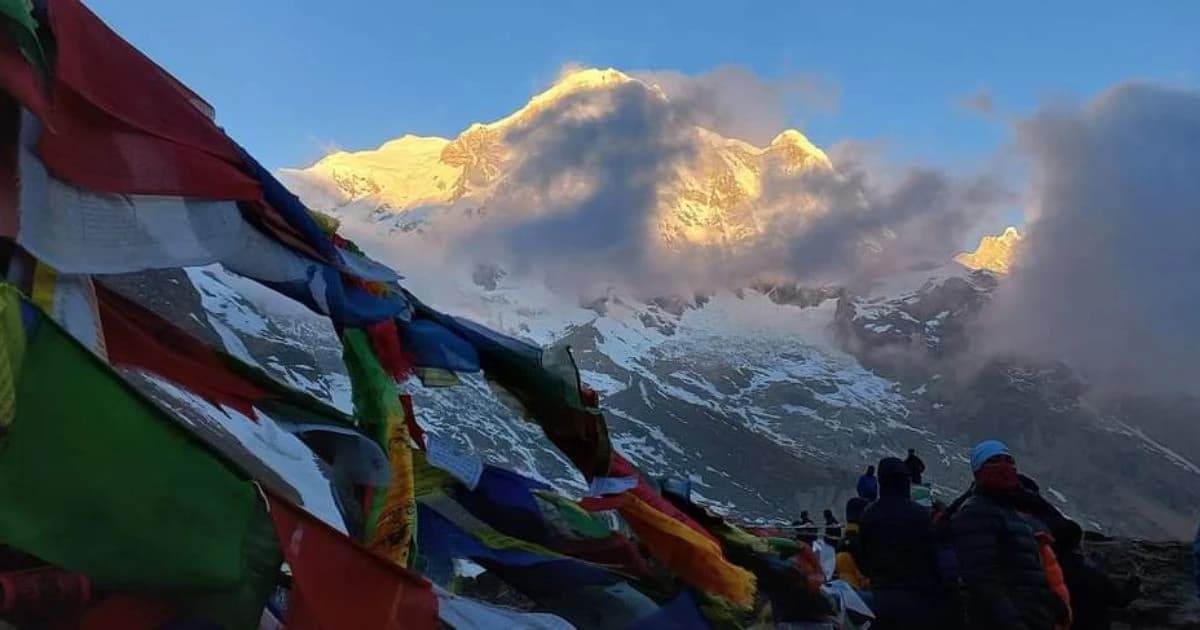So, ABC is on the cards? Awesome! It’s an amazing journey, and we want to help you make the most of every moment. Here are seven really important things to consider before you venture on your journey. Think of this as your friendly heads-up for the adventure of a lifetime.
7 Essential Preparations for Your ABC Trek
The Annapurna Base Camp (ABC) trek is one of the most visited trekking destinations in Nepal. Just the name conjures images of towering snow-capped peaks, forests covered in a pink blanket of blooming rhododendrons, and friendly residents of the area. This particular region has attracted thousands of domestic and foreign visitors alike. It’s an adventure etched into the bucket lists of trekkers worldwide. Only last year, the Annapurna Region welcomed a record-breaking number of 244,045 foreign tourists, according to the Annapurna Conservation Area Project (ACAP). But, simply reaching the base camp isn’t the same as truly enjoying the destination.
So, how can one truly enjoy this overall trek and not just reach the destination? To enjoy every breathtaking view and every cultural exchange and then actually conquer the trail, a thoughtful approach is the key. Proper planning, physical and mental preparation, and packing the right gear are crucial to make your journey enjoyable. So, how do we make sure this journey is filled with memorable moments and not a meltdown at 4,000 meters? Let’s explore seven crucial things to consider for a truly memorable and meaningful Annapurna Base Camp trek.
Physical and Mental Preparation for Annapurna Base Camp Trek
Annapurna Base Camp trek might not be as challenging as other treks or expeditions in Nepal. The trail is well-maintained, and the altitude is not as high as other popular regions. But let’s be real, trekking is hard, and without any pre-trip workout or some basic level of fitness, it’s not going to be easy at all. Your toll for the great trek is paid in sweat.
Preparing for a trek is not limited to physical fitness. You should also be mentally prepared for it. For more than a week, you will be walking deep in the remote areas. You will have to walk with some of your necessities on your back, and the facilities are going to be minimal. So, research the place, set realistic expectations, and understand the challenges you might face, such as limited resources, basic facilities, harsh weather conditions, and, of course, physical discomfort.
Pick the Best Time and Trekking Style
Timing is everything! Picking the right time and the style for your journey that suits you the best is crucial for a successful and enjoyable adventure. Though the Annapurna Region offers trekking opportunities year-round, the best times to visit this region are during the Spring (March to May) and Autumn (September to November) seasons. The Spring welcomes trekkers with blooming rhododendrons and wildflowers, longer days for leisurely trekking, and clear skies with the best stunning views of the mountain. Autumn provides excellent visibility with a post-monsoon landscape of lush green with fresh and clean air. Additionally, Autumn is also the season for several Nepali festivals, offering trekkers to witness unique cultural celebrations.
Also, trekkers can choose from a variety of styles, depending on their fitness level and their preferences. While all of the trekking in this region is overnight, the most common style trekkers go for is the Teahouse Trek. The guests stay in the local guest houses, commonly known as teahouses, which are found along the trail. The tea houses provide basic accommodation and meals, offering them the experience of local culture and hospitality.
For a more distinct experience, trekkers can go for a Camping Trek. This is not common as it involves carrying all the gear and sleeping tents. But this style of trek is best for those who want flexibility and the opportunity to explore areas that go beyond the trail.
Note: For those who are looking for a Luxury Trek with a porter carrying your backpack, stay overnight in a room with an attached bathroom and hot shower, just let your travel company know, and this could be arranged with some additional charges.

Take it Slow, It's not a Sprint for Annapurna Base Camp
Let’s address this, trekking is not a race. The route to the Himalayas demands respect, and with the increasing altitude, your body needs to acclimatize. So, embrace your journey slowly while enjoying all the uniqueness of the trail. You have to plan your itinerary according to the capability of your body, and it is better to resist the urge to push too hard or stick to an overly ambitious itinerary. Trekking should never be about rushing to reach the destination quickly. It should be enjoyed at a leisurely pace, allowing your body to fully experience the surroundings and their culture.
Take your time, it's not a competition. Trekking is not just about reaching the destination. A slow pace is crucial for your body to adjust to the altitude and reduce the risk of altitude sickness. Your journey should be about the experience that includes the entire experience, the views the trail provides, interactions with the locals, and the sense of accomplishment at each step. So, take breaks, snap pictures, or simply soak in the gorgeous surroundings.
Let us help you design a comfortable and well-paced Annapurna Base Camp itinerary that best suits you. Explore our trek options or get in touch for a customized plan!
Pack Smart for a Happy Trek to ABC
Not many people talk about this, but packing smart is very crucial. It is very tempting to pack everything, but a heavy backpack can quickly turn enjoyment into drudgery. So pack only those that are actually essential for the trip and not something that you think you might need. What you bring on your adventure can significantly impact your comfort, safety, and overall experience. The smart aspect of this involves prioritizing truly necessary items and leaving behind anything that will add unnecessary weight. A lighter pack means less strain on your body, making trekking more comfortable, leaving you more energy to appreciate the scenery.
While packing, consider the right gear for the right conditions. Understanding the weather patterns and terrain of Annapurna is the key to packing appropriately. This includes layering clothing, which you can easily remove or put on when you are on the trail. It is better if you have quick-drying day clothes. Bring waterproof and windproof outerwear, sturdy trekking boots, and sun protection.
For more detailed information on the essential packing list and expert advice on gear, be sure to check our blog “Things to Pack for Trekking in Nepal.”
Connect with People and their Culture of Annapurna
One of the best parts of trekking or even just traveling is the unique opportunity to explore the culture of the place and the people who follow it. The Annapurna Base Camp Trek is home to a variety of ethnic groups, each with its unique language, customs, and traditions. Listen to the people and what they have to say, display openness, and be respectful towards the people and their culture. A simple step to get connected to the people and culture would be to learn a few phrases in their language, and in the case of Annapurna Base Camp, just learn simple greetings in Nepali.
Take your time to talk to people you meet along the trail: treehouse owners, villagers, farmers, and even fellow trekkers. Share your own stories and experiences, this helps create meaningful connections, bridge cultural gaps, and find common ground. If you ever get the opportunity, do not hesitate to participate in local festivals or any cultural events.
Eat Good, Rest Well, & Stay Hydrated During the ABC Trek
When you are constantly walking for days, it’s obvious that your body needs to be fueled properly. The physical demand is high, and you will need sustained energy. Try the nutrition-rich local food available at the teahouses. The local staple Dal Bhat with seasonal vegetables is there for a reason, and Nepali people don’t say “Dal-Bhat power 24 hour” for nothing. Pack some dried fruits and nuts for snacking on the trail. And most importantly, drink enough water. You should drink at least 3-4 liters daily. Drink small amounts regularly and take some sips even if you don’t feel thirsty. The Annapurna Base Camp trail has safe sources to refill your bottle, but consider using purification tablets or a filter.
Finally, take proper rest. Your body needs 7-8 hours of sleep at night to recover and acclimate to the environment. Always listen to your body and don’t push yourself beyond your limits. Rest is not just about sleep. It is also about pacing yourself during the day. Take frequent breaks, catch your breath while admiring the beauty of the trail.
Capture Memories, Not Just Photos on Annapurna
It is always a good idea to capture photos of your journey. Photos are wonderful souvenirs for our lifetime. But they can sometimes create a barrier between you and the present moment. Take time to simply enjoy the moment and absorb the beauty around you. The memories you make through your senses last far beyond any photographs.
Consider capturing memories and not just digital photos. You can consider keeping a journal of your journey to Annapurna Base Camp. You can collect small mementos for the sensory details of your journey. Capture the emotions of the people around you rather than capturing them in photographs. These authentic moments will be the most cherished memories you will take from Annapurna Base Camp.

Remember, your trek to Annapurna Base Camp or any other route is not just about ticking off a bucket list. It is about the experience you create along the way. So, don’t let the manageable challenges overshadow the opportunity to connect with nature and the people who call Annapurna their home. Prepare your journey mindfully, choose the right time and style, and pack your bag smart. And while on the trail, listen to your body, respect your own pace, and take the time to connect with people and their culture. The scenery you witness, the connections you build, and the challenges you overcome will become part of your story, which you will carry forever. By following these essential tips and planning thoughtfully, you’ll set the stage for a beautiful adventure. And those seeking expert advice and a customizable itinerary option, you can always contact us. Also, don’t forget to check our Annapurna Base Camp package or explore other packages in the Annapurna Region.





